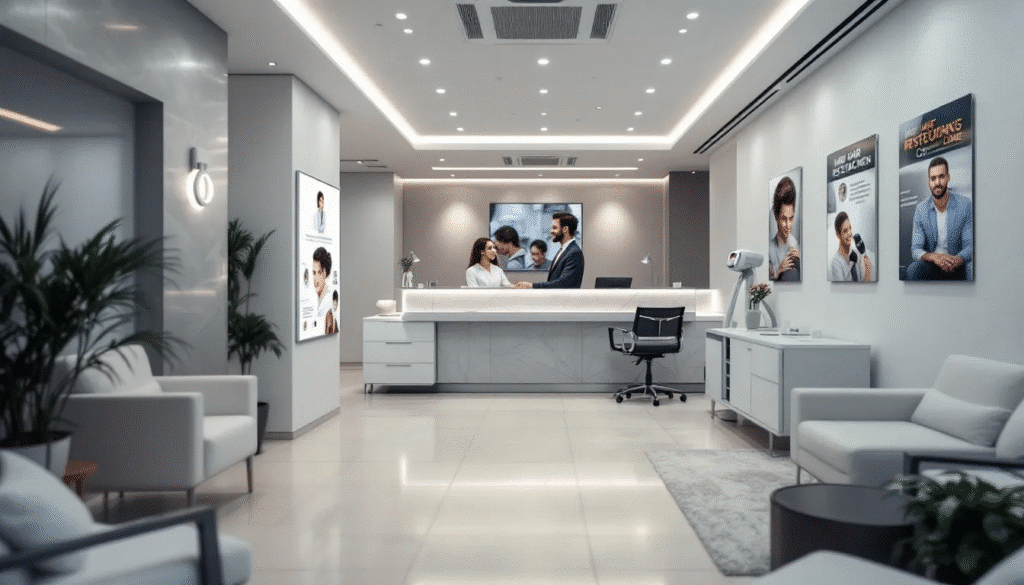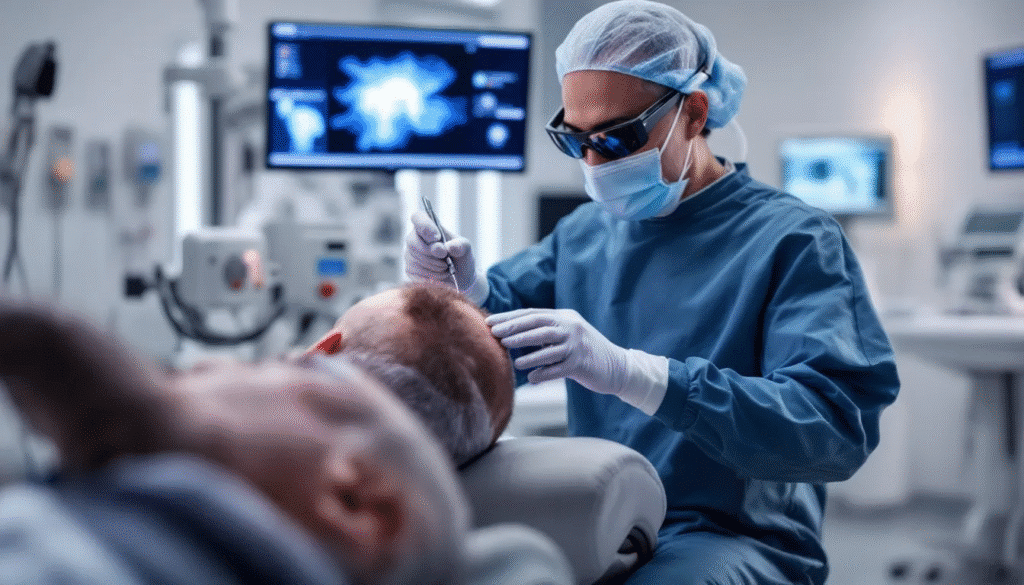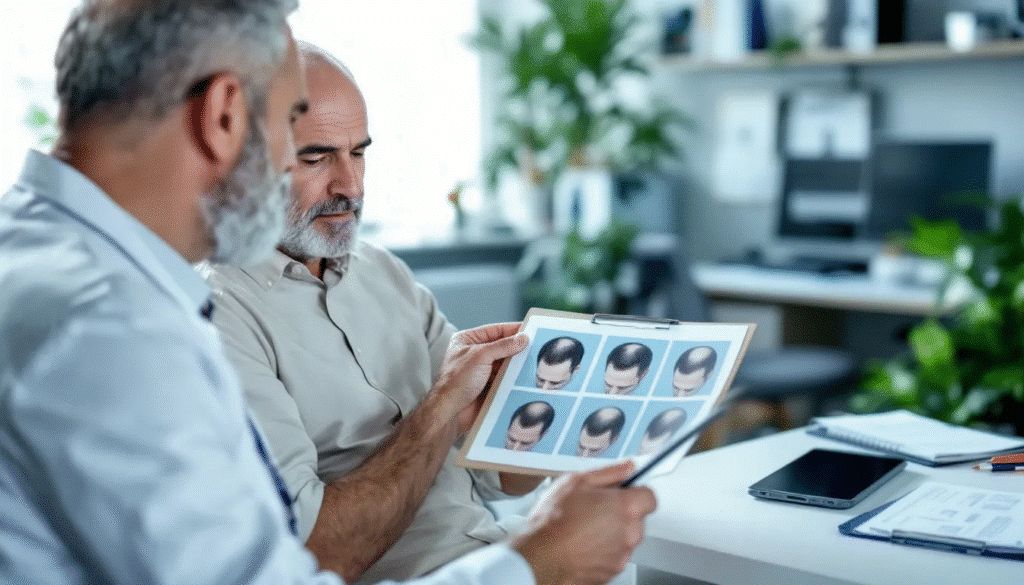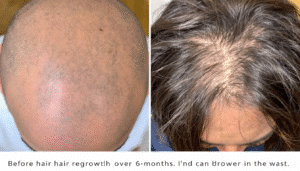Hair loss affects up to 50% of men and 40% of women by age 50, making professional hair restoration one of the fastest-growing medical fields. With the global hair restoration market valued at over $8 billion and growing at 15-18% annually, more people than ever are seeking specialized treatment for thinning hair and pattern baldness. Leading hair replacement centres are recognized around the world for their international standards and global reputation in delivering exceptional results.
Choosing the right hair replacement centre can mean the difference between natural-looking, permanent results and disappointing outcomes. Unlike general dermatology clinics or cosmetic surgery practices, specialized hair replacement centres operate as dedicated medical practices focused solely on hair restoration, emphasizing their expertise and commitment to this field. These practices offer both surgical and non-surgical solutions backed by years of dedicated experience.
This comprehensive guide will walk you through everything you need to know about selecting a hair replacement centre that meets your specific needs, budget, and expectations. From understanding available treatments to evaluating centre credentials and avoiding costly mistakes, you’ll have the knowledge needed to make an informed decision about your hair restoration journey. Top centres are committed to providing a world class experience, ensuring the highest quality of care and patient satisfaction.

What Is a Hair Restoration and Replacement Centre and How Can It Help You
A hair replacement centre is a specialized medical facility dedicated exclusively to treating various forms of hair loss through both surgical and non-surgical methods. These centres differ significantly from general dermatology clinics by focusing solely on hair restoration, allowing them to develop deeper expertise in hair transplant procedures, scalp treatments, and comprehensive hair loss evaluation.
Hair replacement centres treat a wide range of conditions including male pattern baldness (androgenetic alopecia), female hair loss, alopecia areata, and hair loss resulting from medical treatments or trauma. Unlike general practitioners who may perform occasional hair procedures, these specialized centres handle hundreds or thousands of cases annually, developing refined techniques and achieving more consistent results.
The primary advantage of choosing a dedicated hair replacement centre over a general practitioner lies in their specialized focus. These centres invest in advanced technologies like robotic hair transplant systems, maintain teams of highly trained hair transplant surgeons, and offer comprehensive treatment plans that may combine multiple hair restoration techniques for optimal outcomes. Experienced doctors are directly involved in performing and overseeing procedures at these centres, ensuring the highest standards of quality and patient safety.
Modern hair replacement centres typically offer both permanent surgical solutions and temporary non-surgical options. Surgical treatments focus on relocating healthy hair follicles from donor areas to balding regions, while non-surgical approaches include treatments designed to stimulate existing hair growth or provide immediate cosmetic coverage through hair replacement systems.
The comprehensive approach taken by specialized centres often includes ongoing monitoring and maintenance programs, ensuring that patients receive continuous care throughout their hair restoration journey rather than a single procedure followed by minimal follow-up.
Understanding Hair Loss
Hair loss, medically known as androgenetic alopecia, is a widespread condition that impacts both men and women, often leading to thinning hair, bald spots, and a receding hairline. While it’s commonly associated with aging, hair loss can begin as early as your twenties and is influenced by a combination of genetic, hormonal, and environmental factors. For many, the emotional impact of hair loss can be significant, affecting self-esteem and confidence.
The American Board of Hair Restoration Surgery emphasizes the importance of seeking professional guidance when you notice signs of hair loss. A board-certified hair transplant surgeon can provide a thorough evaluation to determine the underlying causes of your thinning hair or bald spots. During your consultation, the surgeon will assess your hairline, scalp health, and family history to recommend the most effective hair restoration treatment for your unique situation.
Options may include hair restoration surgery, non-surgical hair restoration techniques, or a combination of both, depending on the extent and pattern of your hair loss. Women, in particular, may experience diffuse thinning rather than distinct bald spots, requiring a tailored approach. By consulting with a qualified professional, you can develop a personalized treatment plan that addresses your specific needs and helps restore both your hair and your confidence.
Essential Services Offered by Modern Hair Replacement Centres
Contemporary hair replacement centres offer a comprehensive range of services designed to address different types and stages of hair loss, including advanced hair restoration procedures. Understanding these services helps you evaluate whether a particular centre can meet your specific needs and treatment goals.
Follicular Unit Extraction (FUE) represents the most advanced surgical hair restoration technique available today. This minimally invasive hair transplant procedure involves extracting individual hairs (hair follicles) from the donor area and transplanting them to areas experiencing hair loss. FUE procedures typically achieve success rates of 90-95% and leave minimal scarring, making them ideal for patients who prefer shorter hairstyles.
Follicular Unit Transplantation (FUT), also known as the strip method, involves removing a strip of scalp from the donor area for transplantation. While this technique leaves a linear scar, it allows surgeons to harvest larger numbers of grafts in a single session, making it suitable for patients requiring extensive hair restoration. Modern FUT techniques have significantly improved scar minimization and healing outcomes.
Hair implants are another specific hair restoration option, involving the implantation of hair follicles to achieve natural-looking results. This hair restoration procedure is recognized for its effectiveness, safety, and the natural appearance it provides when performed by skilled surgeons.
Platelet-Rich Plasma (PRP) therapy utilizes the patient’s own blood platelets to stimulate hair growth and improve scalp health. This non-surgical treatment involves injecting concentrated platelets into areas of thinning hair, promoting natural hair follicle regeneration and potentially slowing future hair loss progression.
Scalp micropigmentation offers a non-surgical solution that creates the appearance of fuller hair through specialized tattooing techniques. This treatment works particularly well for patients with advanced hair loss who want the appearance of a closely shaved head with natural-looking hair follicles.
Low-level laser therapy (LLLT) and regenerative medicine options provide additional non-invasive treatments that many centres incorporate into comprehensive treatment plans. These therapies can enhance results from surgical procedures or serve as standalone treatments for patients in early stages of hair loss.
Quality hair replacement centres also provide thorough hair loss evaluation and diagnosis services, including detailed scalp analysis, trichoscopy examination, and assessment of underlying causes contributing to hair loss. This diagnostic phase ensures that recommended treatments address the root causes of hair loss rather than just cosmetic symptoms.
Advanced Technologies and Techniques Used in Hair Replacement Centres
Leading hair replacement centres distinguish themselves through investment in cutting-edge technologies that improve precision, reduce recovery time, and enhance natural-looking results. Understanding these technological capabilities can help you identify centres that offer the most advanced treatment options. Hair transplantation is a surgical procedure that involves moving hair follicles from one part of the scalp to another, providing a permanent solution for hair loss.
Robotic-assisted hair transplant systems represent the pinnacle of hair restoration technology. These systems use artificial intelligence and precision robotics to select and extract the healthiest hair follicles while maintaining optimal angles and depths. Robotic systems significantly reduce human error and can process larger numbers of grafts with consistent quality, though they require substantial investment that only established centres typically make.
Stem cell therapy and growth factor treatments utilize regenerative medicine principles to enhance hair follicle survival and promote new hair growth. These treatments often complement traditional hair transplant procedures by improving the scalp environment and supporting transplanted hair follicles during the critical initial healing period.
Digital imaging and 3D planning software enable surgeons to design hairlines and plan graft placement with unprecedented precision. These systems allow patients to visualize projected results before treatment and help surgeons create natural-looking hairlines that complement individual facial features and aging patterns.
Microscopic follicle preparation and preservation techniques ensure maximum graft survival rates by maintaining optimal conditions for harvested hair follicles. Advanced centres use specialized storage solutions and temperature-controlled environments to preserve follicle viability during the time between extraction and implantation.
Minimally invasive extraction methods continue to evolve, with some centres offering techniques that reduce extraction trauma and accelerate healing. In procedures such as FUE, hair follicles are carefully extracted from the skin of the donor area, ensuring minimal damage and optimal graft quality. These methods often result in less discomfort, faster recovery times, and improved overall patient experiences compared to traditional approaches.
The combination of these advanced technologies often produces superior outcomes compared to centres using older techniques, though the investment in such technology is typically reflected in treatment costs. These innovations are designed to achieve natural results, ensuring that restored hair blends seamlessly with the patient’s existing hair for an authentic appearance.

Qualifications and Experience of the Medical Team
When considering hair restoration, the expertise and credentials of your medical team are paramount to achieving natural, lasting results. Look for a clinic staffed by highly trained, board-certified hair transplant surgeons who are active members of respected organizations such as the International Society of Hair Restoration Surgery. These affiliations demonstrate a commitment to ongoing education and adherence to the highest standards in hair restoration surgery.
A skilled medical team will have extensive experience performing a wide range of hair restoration techniques, including follicular unit extraction (FUE), follicular unit transplantation (FUT), and other advanced procedures. Their proficiency ensures that each patient receives a customized approach, whether the goal is to restore a natural hairline, increase density, or address specific areas of thinning hair.
Before choosing a clinic, take the time to research the medical team’s background. Review their credentials, read patient testimonials, and ask for referrals to verify their track record of delivering natural-looking results. A reputable team will be transparent about their experience, share before-and-after photos, and answer your questions thoroughly, ensuring you feel confident and informed throughout your hair restoration journey.
Facilities and Equipment: What to Look For
The quality of a clinic’s facilities and equipment plays a crucial role in the success of your hair transplant procedure. A state-of-the-art clinic should be equipped with the latest technology, including high-resolution microscopes and precision surgical instruments, to ensure the careful handling and placement of hair grafts. These tools are essential for maximizing graft survival and achieving a natural-looking result.
In addition to advanced equipment, the clinic environment should be sterile, comfortable, and designed with patient safety in mind. A well-organized facility will have experienced technicians and nurses who work closely with the hair transplant surgeon to support every step of the procedure, from preparation to post-operative care.
Before committing to a clinic, schedule a consultation to tour the facility and meet the medical team. This visit allows you to assess the clinic’s standards of cleanliness, professionalism, and patient care. A quality clinic will welcome your questions and provide a transparent overview of their procedures, ensuring you feel comfortable and confident in your choice.
Non-Surgical Hair Restoration Options
Not every patient is a candidate for hair transplant surgery, and some may prefer to explore non-surgical hair restoration options first. Today’s non-invasive treatments offer effective solutions for stimulating hair growth and improving the appearance of thinning or balding areas without the need for surgery.
Low-level laser therapy (LLLT) uses gentle light energy to stimulate hair follicles and promote hair growth, making it a popular choice for early-stage hair loss. Platelet-rich plasma (PRP) therapy involves drawing a small amount of your blood, processing it to concentrate the platelets, and injecting it into the scalp to encourage natural hair regrowth. For those seeking immediate cosmetic improvement, hair systems such as custom hairpieces or wigs can provide a full, natural look without surgery.
Each of these options has its own benefits and considerations. Consulting with a hair restoration specialist is the best way to determine which non-surgical treatment aligns with your hair loss pattern, scalp health, and personal goals. With professional guidance, you can develop a comprehensive plan to address your hair restoration needs—whether you choose non-surgical treatments, surgery, or a combination of both.
Female Hair Restoration: Special Considerations
Hair restoration for women requires a specialized approach, as female hair loss often presents differently than male pattern baldness. Female androgenetic alopecia typically results in diffuse thinning across the scalp rather than distinct bald spots or receding hairlines. Hormonal changes, genetics, and life events such as menopause can all contribute to hair loss in women.
Hair restoration surgery, including hair transplant procedures, can be highly effective for female patients, but success depends on a nuanced understanding of female hair patterns, hair texture, and styling preferences. A qualified hair restoration specialist will conduct a thorough evaluation to identify the underlying causes of hair loss and develop a personalized treatment plan tailored to each woman’s unique needs.
Treatment options may include surgical hair transplants, non-surgical therapies, or a combination designed to achieve the most natural and satisfying results. By working closely with an experienced professional, women can restore not only their hair but also their confidence, enjoying a fuller, healthier head of hair that complements their individual style and life stage.
Understanding Hair Replacement Centre Costs and Financing Options
Hair restoration costs vary significantly based on treatment type, centre location, surgeon experience, and individual patient needs. Understanding pricing structures and available financing options helps you budget appropriately and avoid unexpected expenses.
FUE procedure costs typically range from $3 to $8 per graft, with most patients requiring 1,000 to 3,000 grafts depending on the extent of hair loss. Total costs usually range from $4,000 to $15,000 for surgical procedures, with premium centres and highly experienced surgeons commanding higher fees. The per-graft pricing model means that more extensive hair loss requires proportionally higher investment.
FUT surgery costs often provide better value for patients requiring large numbers of grafts, as the strip method allows harvesting more follicles in a single session. FUT procedures typically cost 20-30% less than equivalent FUE treatments, though patients must accept the trade-off of linear scarring.
Non-surgical treatment costs vary widely based on treatment type and frequency requirements. PRP therapy sessions typically cost $300 to $800 each, with most patients requiring 3-6 initial treatments followed by periodic maintenance sessions. Hair replacement systems range from $1,000 to $3,000 initially, with ongoing maintenance costs of $200 to $500 every 6-8 weeks.
Insurance coverage considerations remain limited for most hair restoration treatments, as insurers typically classify these procedures as cosmetic rather than medically necessary. However, some treatments for hair loss caused by medical conditions or trauma may qualify for partial coverage. Consulting with both your insurance provider and the hair replacement centre about coverage possibilities is advisable.
Most established hair replacement centres offer financing options including payment plans, medical credit lines, and partnerships with healthcare financing companies. These options often allow patients to spread treatment costs over 12-60 months, making premium treatments more accessible.
Hidden costs to consider include prescription medications, special shampoos and care products, follow-up appointments, and potential touch-up procedures. Some centres include these costs in comprehensive packages, while others charge separately. Clarifying total treatment costs upfront prevents unexpected expenses later.
When comparing costs between centres, consider the value proposition rather than focusing solely on price. Factors like surgeon experience, technology used, facility standards, and included follow-up care often justify higher costs through better results and reduced risk of complications. Investing in a reputable centre often leads to the best outcomes for patients.
How to Choose the Best Hair Replacement Centre for Your Situation
Selecting the right hair replacement centre requires careful evaluation of multiple factors that impact both treatment quality and your overall experience. A systematic approach to centre evaluation helps ensure you receive the best possible care for your investment.
Board certification requirements and professional memberships serve as fundamental indicators of centre quality. Look for hair transplant surgeons certified by relevant medical boards and membership in the International Society of Hair Restoration Surgery (ISHRS). These credentials indicate adherence to professional standards and ongoing education in the latest techniques.
Experience levels and procedure volume directly correlate with treatment outcomes. Centres performing hundreds of procedures annually typically achieve more consistent results than those handling occasional cases. Ask about the surgeon’s specific experience with your planned procedure type and request information about their annual case volume.
Before-and-after photo galleries provide crucial insight into a centre’s capability to achieve natural-looking results. Quality centres maintain extensive portfolios showing diverse patient types and various degrees of hair loss. Pay attention to hairline design, overall naturalness, and results that match your hair type and loss pattern. Leading centres often showcase patients who have achieved a natural appearance with more hair, highlighting the quality of hair growth and the realistic look of the outcomes.
Patient testimonials and reviews offer valuable perspectives on the complete treatment experience beyond just visual results. Look for testimonials that discuss the consultation process, staff professionalism, post-operative care quality, and long-term satisfaction with results. Online review platforms can provide additional unfiltered patient feedback.
Facility accreditation and safety standards ensure that your treatment takes place in a properly equipped and regulated environment. Accredited surgical facilities maintain strict safety protocols, emergency preparedness, and infection control measures that reduce treatment risks.
The consultation process itself reveals much about a centre’s approach to patient care. Quality centres provide thorough evaluations, realistic expectation setting, and detailed treatment planning without high-pressure sales tactics. Consultations should include scalp analysis, discussion of alternative treatments, and clear cost breakdowns.
Geographic accessibility becomes important for follow-up care and any necessary revision procedures. While traveling for treatment is sometimes worthwhile for exceptional centres, consider the practical implications of post-operative care and long-term monitoring requirements.
What to Expect During Your Hair Replacement Centre Experience
Understanding the complete treatment timeline helps you prepare appropriately and set realistic expectations for your hair restoration journey. The process typically spans several months from initial consultation to final results.
The initial consultation process begins with a comprehensive hair loss assessment including medical history review, scalp examination, and discussion of treatment goals. Quality centres use specialized imaging equipment to analyze hair density, scalp laxity, and donor area quality. This evaluation determines your candidacy for different treatments and helps design an appropriate treatment plan.
Expect discussions about realistic outcomes based on your specific situation, including limitations imposed by donor hair availability, existing hair characteristics, and natural aging patterns. Reputable centres provide honest assessments rather than promising unrealistic results.
Pre-operative preparation for surgical procedures typically includes medical clearance, temporary medication adjustments, and specific care instructions. Some centres require blood work or other tests to ensure surgical safety. You’ll receive detailed instructions about avoiding certain medications, alcohol, and smoking before your procedure.
Day-of-surgery procedures vary based on treatment type but generally follow predictable timelines. FUE procedures typically take 4-8 hours depending on graft numbers, while FUT surgeries may require similar timeframes. You’ll receive local anesthesia and can expect to remain awake and comfortable throughout the procedure.
Most centres provide entertainment options, meals, and comfort measures to make lengthy procedures more pleasant. Understanding the timeline helps you arrange appropriate time off work and post-procedure transportation.
Post-operative care includes specific washing instructions, medication schedules, and activity restrictions. Initial healing typically takes 7-10 days, during which you’ll need to avoid strenuous activities and follow detailed scalp care protocols. Most patients return to work within a week for FUE procedures and slightly longer for FUT surgeries.
Recovery timeline and result expectations extend far beyond initial healing. Transplanted hair typically falls out within 2-3 weeks before beginning permanent regrowth around month 3-4. Final results become apparent 9-12 months after surgery, requiring patience throughout the hair growth cycle.
Quality centres provide regular follow-up appointments to monitor healing, address concerns, and track progress toward final results. This ongoing relationship ensures optimal outcomes and early intervention if any issues arise.

Success Rates and Long-Term Outcomes from Hair Replacement Centres
Understanding realistic success rates and long-term outcomes helps you set appropriate expectations and evaluate potential centres based on their documented results. Industry data provides benchmarks for comparing centre performance.
Industry-standard success rates for modern hair transplant procedures consistently exceed 90-95% for FUE and FUT techniques when performed by experienced surgeons. Success is typically measured by graft survival rates, natural appearance, and patient satisfaction rather than just hair growth alone.
Several factors significantly influence treatment success and graft survival rates. Surgeon experience, technique precision, post-operative care quality, and patient compliance with instructions all impact final outcomes. Centres with higher procedure volumes and specialized focus typically achieve better results than those performing occasional hair restoration surgeries.
Patient health factors also influence success rates, including age, overall health status, smoking habits, and underlying medical conditions affecting hair growth. Quality centres conduct thorough evaluations to identify patients most likely to achieve excellent results while advising others about potential limitations.
Realistic expectations for hair density vary based on available donor hair and recipient area size. Most patients achieve 40-60% of original hair density in treated areas, which typically appears natural and provides significant cosmetic improvement. Complete restoration to original density is rarely possible and shouldn’t be promised by reputable centres.
The long-term permanence of transplanted hair follicles represents one of the key advantages of surgical hair restoration. Transplanted follicles retain the characteristics of their donor area, remaining resistant to the hormonal factors causing pattern baldness. This means transplanted hair typically continues growing throughout the patient’s lifetime.
Patient satisfaction surveys consistently show high levels of satisfaction with hair restoration results, with most studies reporting 85-90% satisfaction rates one year post-treatment. Satisfaction correlates strongly with realistic pre-treatment expectations, quality post-operative care, and natural-looking results.
Quality of life improvements following successful hair restoration often exceed purely cosmetic benefits. Patients frequently report increased confidence, improved social interactions, and enhanced professional opportunities following treatment. These psychological benefits often justify the investment for many patients even beyond the aesthetic improvements.
Long-term follow-up studies spanning 10-15 years demonstrate sustained satisfaction with hair transplant results, indicating that the benefits of quality treatment continue well beyond the initial healing period.
Red Flags to Avoid When Selecting a Hair Replacement Centre
Recognizing warning signs helps you avoid centres that may compromise your safety, results, or financial investment. Being aware of these red flags protects you from costly mistakes and potentially harmful experiences.
Only licensed physicians should perform hair transplant surgeries, though trained technicians may assist under direct physician supervision.
Unrealistic promises and guaranteed results indicate centres more focused on sales than patient care. Reputable centres discuss realistic expectations, potential limitations, and individual variation in results rather than guaranteeing specific outcomes. Be particularly wary of promises about exact hair density numbers or unrealistic timelines.
Lack of proper certification and medical credentials can be verified through medical board websites and professional organizations. Centres should readily provide information about surgeon credentials, board certifications, and professional memberships. Reluctance to share this information or inability to verify credentials represents a significant red flag.
High-pressure sales tactics and immediate procedure scheduling often indicate centres prioritizing profit over patient care. Quality centres encourage patients to take time for decision-making, seek second opinions, and thoroughly research their options. Pressure to schedule immediately or limited-time pricing offers should raise concerns about centre priorities.
Inadequate facility standards and outdated equipment can compromise both safety and results. Facilities should meet medical standards for surgical procedures, maintain current technology, and demonstrate adherence to infection control protocols. Tours of the facility should reveal professional, well-maintained environments suitable for medical procedures.
Poor patient reviews and complaint patterns often reveal consistent problems with centre operations, results quality, or patient care. While isolated negative reviews are normal, patterns of similar complaints about results, billing practices, or post-operative care warrant serious consideration.
Additional warning signs include lack of detailed treatment planning, unwillingness to discuss risks and limitations, inadequate post-operative care protocols, and billing practices that seem unclear or predatory. Trust your instincts if something feels wrong about a centre’s approach or staff interactions.
Frequently Asked Questions About Hair Replacement Centres
How long do hair replacement procedures take to complete?
Hair transplant procedures typically require 4-8 hours depending on the number of grafts being transplanted. FUE procedures may take slightly longer due to the individual extraction process, while FUT surgeries can often be completed more quickly for large graft numbers. Non-surgical treatments like PRP therapy usually take 30-60 minutes per session.
Are hair transplants from replacement centres permanent solutions?
Yes, surgical hair transplants provide permanent results because transplanted hair follicles retain the characteristics of their donor area, which is typically resistant to pattern baldness. The transplanted hair will continue growing throughout your lifetime, though you may experience continued hair loss in untreated areas and potentially require future procedures.
What is the typical age range for hair replacement centre patients?
Most hair replacement centres treat patients ranging from their late 20s to their 70s. The ideal age depends on hair loss stability, overall health, and individual goals. Younger patients (under 25) are often advised to wait until their hair loss pattern stabilizes, while older patients may have excellent results if they’re in good health.
Can women benefit from hair replacement centre treatments?
Absolutely. Female hair loss affects up to 40% of women by age 50, and women often achieve excellent results from both surgical and non-surgical treatments. Female hair restoration often focuses on increasing density rather than recreating hairlines, and many techniques are specifically adapted for female hair loss patterns.
How do I prepare for my first consultation at a hair replacement centre?
Bring a complete medical history including current medications, any previous hair loss treatments, and family history of hair loss. Avoid cutting your hair very short before the consultation so the doctor can properly evaluate your current hair condition. Prepare questions about treatment options, costs, and expected outcomes. Consider bringing photos showing your hair loss progression over time.

Taking the Next Step: Scheduling Your Hair Replacement Centre Consultation
Once you’ve researched potential hair replacement centres and identified qualified candidates, the consultation process becomes your opportunity to evaluate centres firsthand and make final selection decisions.
Essential questions to ask during your consultation include inquiries about the surgeon’s specific experience with your hair loss type, expected results based on your individual situation, detailed cost breakdowns including any potential additional expenses, and the centre’s approach to post-operative care and follow-up.
Ask to see before-and-after photos of patients with similar hair loss patterns and hair characteristics to yours. Discuss alternative treatment options and why the recommended approach is most suitable for your situation. Understanding the reasoning behind treatment recommendations helps you evaluate the centre’s expertise and approach to individualized care.
Documentation and medical history to bring includes current medications, previous hair loss treatments, family history of hair loss, and any medical conditions that might affect healing. Photos showing your hair loss progression over time can help the surgeon understand your hair loss pattern and progression rate.
Multiple consultation strategy allows you to compare different centres, treatment approaches, and cost structures before making final decisions. Most reputable centres offer free or low-cost consultations, making it practical to evaluate several options. Comparing recommendations from different centres often provides valuable insights into treatment necessity and approach variations.
Timeline considerations for decision-making should account for research time, potential waiting periods for preferred surgeons, and your personal schedule for recovery time. Popular centres may have several months of lead time for scheduling procedures, particularly during peak seasons.
Financial planning should include not just the initial procedure cost but also financing arrangements, payment schedules, and budgeting for any recommended follow-up treatments. Many centres offer flexible payment options, but understanding the complete financial commitment helps you plan appropriately.
Consider the timing of your procedure relative to work commitments, social events, and seasonal factors that might affect your recovery experience. Planning ahead ensures you can dedicate appropriate time to healing and follow-up care without rushing back to normal activities prematurely.
The consultation process itself serves as an important evaluation tool for assessing the centre’s professionalism, attention to detail, and commitment to patient care. The quality of your consultation experience often predicts the quality of care you’ll receive throughout your treatment journey.
Conclusion
Choosing the right hair replacement centre represents a significant decision that impacts both your appearance and your investment in hair restoration. The key to success lies in thorough research, realistic expectations, and careful evaluation of centre credentials, experience, and approach to patient care.
Quality hair replacement centres distinguish themselves through board-certified surgeons, advanced technologies, comprehensive treatment options, and commitment to natural-looking results. While costs vary significantly, the value of excellent results and professional care often justifies premium pricing compared to budget alternatives that may compromise outcomes.
Your hair restoration journey begins with education and careful centre selection, but the relationship with your chosen centre extends well beyond the initial procedure. The best centres provide ongoing support, monitoring, and care that ensures optimal long-term results and satisfaction with your investment.
Take time to research thoroughly, consult with multiple centres, and trust your instincts about which centre provides the expertise, technology, and patient care approach that best matches your needs and expectations. With careful selection and realistic expectations, hair replacement centres can provide life-changing results that restore both your hair and your confidence for years to come.

